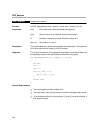
DSP_mul32
4-66
32-Bit Vector Multiply
DSP_mul32
Function void DSP_mul32(const int * restrict x, const int * restrict y, int * restrict r, short
nx)
Arguments x[nx] Pointer to input data vector 1 of size nx. Must be double-word
aligned.
y[nx] Pointer to input data vector 2 of size nx. Must be double-word
aligned.
r[nx] Pointer to output data vector of size nx. Must be double-word
aligned.
nx Number of elements in input and output vectors. Must be multiple
of 8 and ≥16.
Description The function performs a Q.31 x Q.31 multiply and returns the upper 32 bits of
the result. The result of the intermediate multiplies are accumulated into a
40-bit long register pair, as there could be potential overflow. The contribution
of the multiplication of the two lower 16-bit halves are not considered. The
output is in Q.30 format. Results are accurate to least significant bit.
Algorithm In the comments below, X and Y are the two input values. Xhigh and Xlow
represent the upper and lower 16 bits of X. This is the C equivalent of the
assembly code without restrictions. Note that the assembly code is hand
optimized and restrictions may apply.
void DSP_mul32(const int *x, const int *y, int *r,
short nx)
{
short i;
int a,b,c,d,e;
for(i=nx;i>0;i−−)
{
a=*(x++);
b=*(y++);
c=_mpyluhs(a,b); /* Xlow*Yhigh */
d=_mpyhslu(a,b); /* Xhigh*Ylow */
e=_mpyh(a,b); /* Xhigh*Yhigh */
d+=c; /* Xhigh*Ylow+Xlow*Yhigh */
d=d>>16; /* (Xhigh*Ylow+Xlow*Yhigh)>>16 */


















